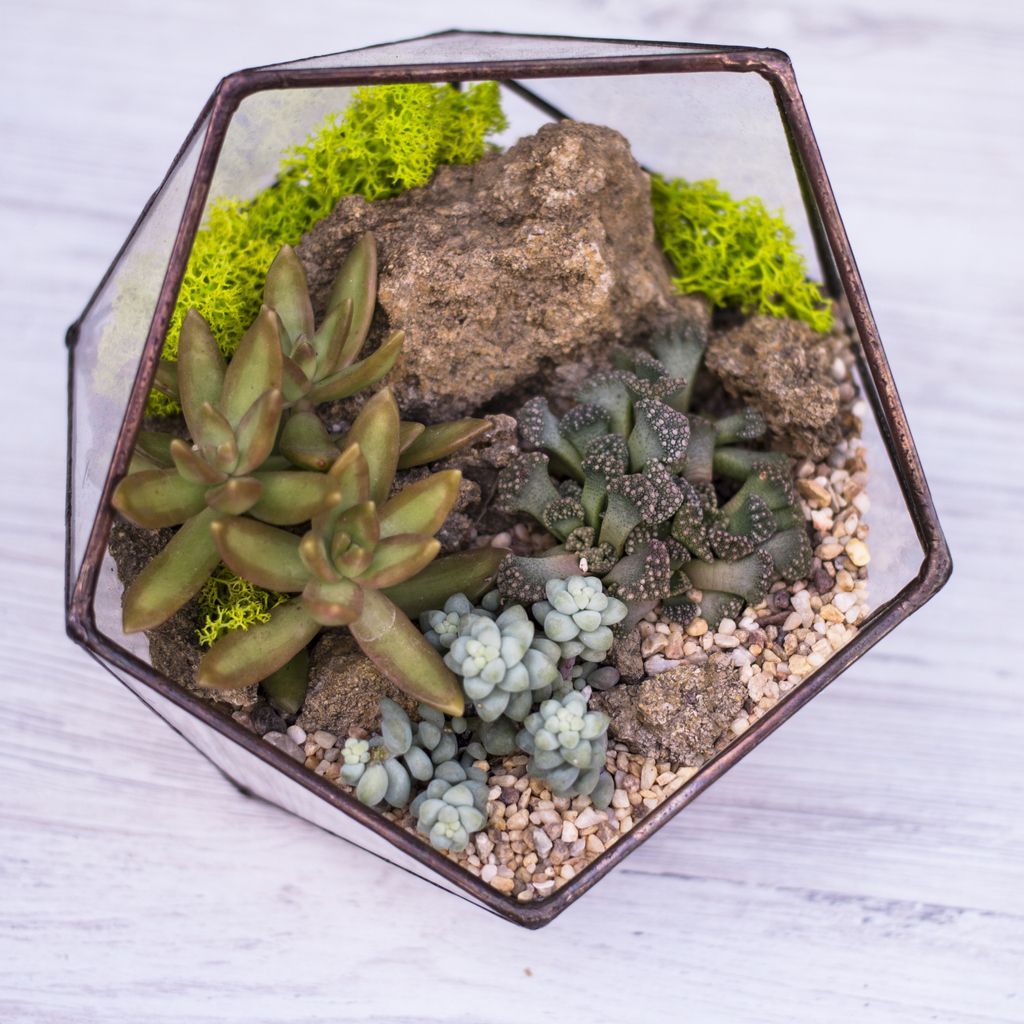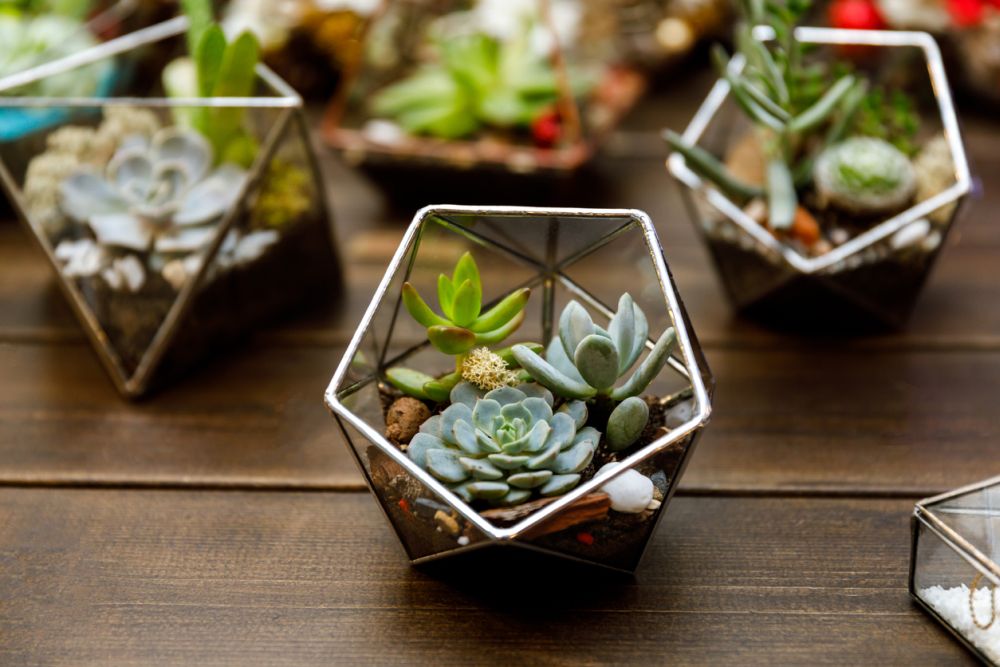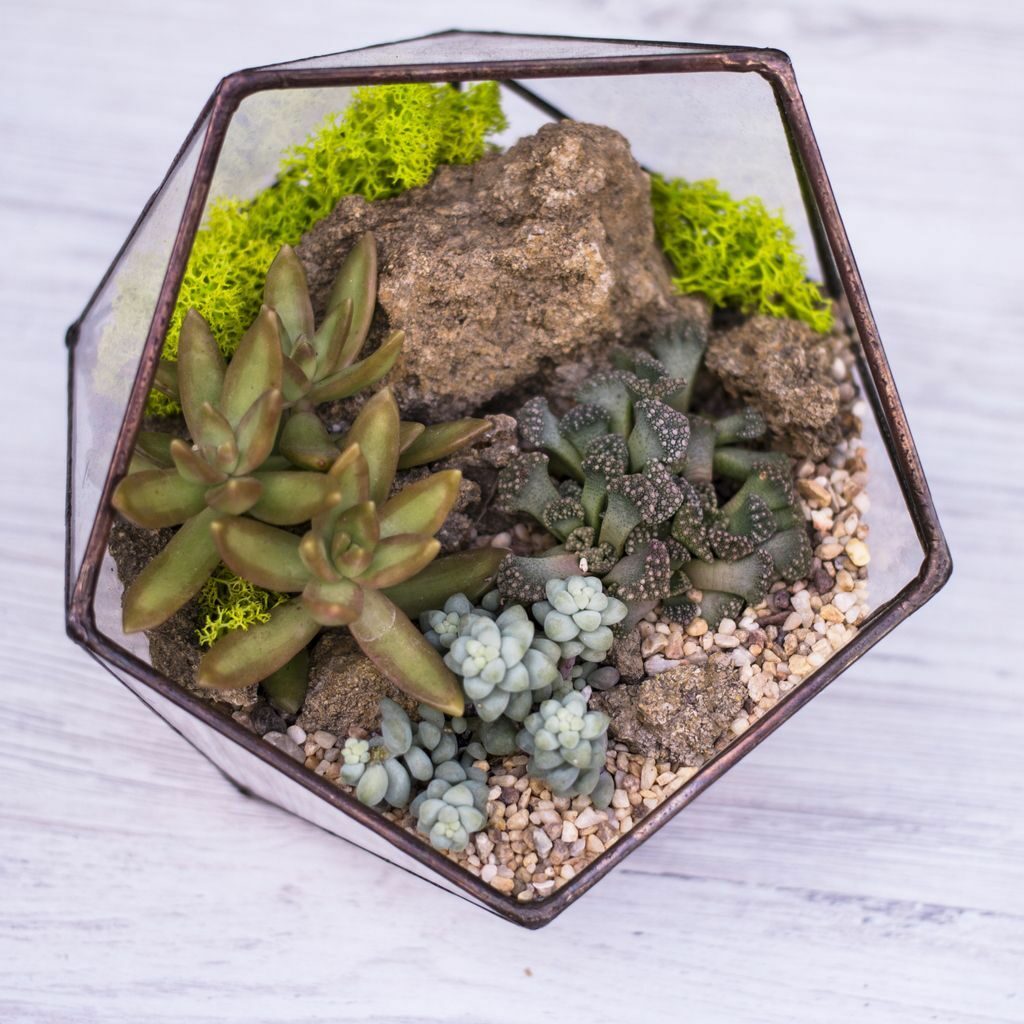Succulent Terrarium Care: How To Make A Succulent Terrarium
A succulent terrarium combines your love for plants along with your passion for art to create a living and breathing piece of home decor. Unlike regular pots, planters, and hanging baskets, a terrarium allows you to get as creative as you like not just with the types of succulents you can group together, but also in the accessories and decorations.
The best part is, when it comes to succulent terrariums, you have many options at your disposal. Based on the color scheme in your house and the succulents you can get your hands on, you can come up with any design you like.
As for the terrarium type, you always have a choice between open and close terrariums. Some people prefer an open succulent terrarium since it provides the succulents with better air flow, reduces the risk of condensation and mold, and has a better chance of success. That said, closed terrariums have their fans as well. People favor them because they are self-sufficient, require zero maintenance, and are better suited to tropical plants as well.
If you’re new to terrariums, we recommend starting with an open succulent terrarium. Succulents are notoriously easy to grow and care for. Besides, a succulent terrarium always looks good in any setting and gives you a chance to show your gardening skills even if you don’t have a garden.
Types of Plants for Terrariums
Succulents have thousands of species and each has its own requirements of light, water, fertilizers, and differing lifespan. So, you’ll need to choose the right species for your terrarium. Here we group together the different succulents that you can grow in the same succulent terrarium based on the conditions in your household.
- Bright Light (Open Terrarium): If you’re blessed with enough natural light inside your home all year round, then you have many succulents, air plants, and houseplants to choose from. The most likely candidates for an open terrarium under these conditions are Widow’s-thrill (Kalanchoe Blossfeldiana), Echeveria, Haworthia, Chocolate soldier (Kalanchoe Tomentosa), Jade (Crassula Ovata), and Sempervivum.
- Medium Light (Open Terrarium): Not all houses are flooded with bright sunlight 10 hours a day. This is especially true if you live in a low-level apartment and you have limited access to sunlight on a normal day. Luckily, some succulents are adapted to filtered light and partial shade. If you’re making an open terrarium, you should use ferns especially Autumn, Woodland, or Button ferns, Peperomia with a special focus on Parallel, Ripple, or Chinese Money Plant. Other options also include Selaginella, Polka Dot Plant, Dracaena, and Pilea especially Friendship Plant, Glauca, and Depressa.
- Medium Light (Closed Terrarium): For closed succulent terrariums, you can plant Baby’s Tears (Helxine Soleirolii), Nerve Plant (Fittonia), Asparagus Fern (Plumosa Nanus), Neanthe Bella Palms, or Oxalis Triangularis.
- Low Light (Closed Terrarium): So what if you have dim to low light in your apartment or office? Does that mean you can’t have a succulent terrarium? The following succulents come to the rescue. Pillow moss, sheet moss, and mood moss are the type of plants that do well in poor light conditions.
Materials Needed for a Succulent Terrarium
The materials you’ll need to make your first succulent terrarium vary depending on the type of terrarium (open or closed), the type of succulent you want to grow, and the design you have in mind. Here, we’ll focus on a general-purpose, open succulent terrarium. The materials you’ll need are the following.
- Glass bowl (similar to a fishbowl or any shape and design of your choosing).
- Succulent plants.
- Perlite or activated charcoal (for managing odors and fungus).
- Pebbles for drainage.
- Peat moss.
- Succulent potting mix.
- Rocks and shells for decoration.
- Garden trowel.
You can add more materials according to your specific needs.
How to Make a Succulent Terrarium
With all the materials at hand and your choice of succulents already on the table, you’re ready to make your open terrarium. Here’s how to make a succulent terrarium in easy steps.
- Make sure the glass bowl is clean to prevent fungal infections that become hard to get rid of once the plants are growing in the terrarium.
- Place the pebbles at the bottom of the bowl as the first layer. This is necessary to improve aeration and drainage since the glass bowl doesn’t have drainage holes. A one- to two-inch layer is good enough.
- The next layer is the perlite or charcoal. Either material will do for most succulents. They help reduce condensation in the bowl, eliminate odors, and prevent the fungus from growing inside the terrarium.
- The peat moss comes on top of the perlite. The idea is the moss will separate the potting soil from the perlite or charcoal to protect the roots of the succulents.
- Take the succulent plants out of their respective pots and ruffle up the roots. Spread the roots and trim down long roots. On average the roots shouldn’t be longer than the depth of the potting mix layer.
- The top layer of the terrarium is for the soil. Spread the succulent potting mix generously to cover the moss with a layer at least 3 inches thick. For large glass bowls, you could use less soil without impacting the growth of the succulents.
- Use the garden trowel to dig a small hole in the soil for each plant. Ease the succulent in the hole and fill it with more potting mix. Pack the soil firmly around the base to push out air pockets. Do the same for the rest of the succulents.
- Water the terrarium lightly taking care not to overwater it. You only have limited soil in the bowl and you wouldn’t want it to become wet.
- Add the rocks, shells, and other decorative materials.
- Place the terrarium near a window that gets at least 6 hours of sunlight every day.
Succulent Terrarium Care
There’s a common misconception among people who have succulent terrariums. Many people believe that a succulent terrarium doesn’t need maintenance and care. While that is true of closed terrariums, open succulent terrariums still need watering, feeding, and pruning just like any other houseplant. Maybe the amount of work here is less, but you still need to care for your plants to ensure they are healthy.
Watering
The watering needs of your succulent terrarium will vary not just from regular plants growing in planters and pots, but also depending on the types of succulents you grow. Since the terrarium doesn’t have drainage holes, you’ll need to water the plants judiciously. One thing to keep in mind is that the plants in the terrarium don’t need as much water as those growing in the garden. If you overwater them, that excess water will drop to the bottom of the terrarium where it will become fertile grounds for fungi and bacteria of all types. So, always water the succulents enough to get the soil moist and give them time for that moisture to dry out completely.
Cleaning
Dust and condensation are the two biggest maintenance issues when it comes to terrariums. But while open terrariums don’t have the same problem with condensed vapor as closed ones, dust is a big issue. Not only does the glass get covered with a thin film of dust every now and then, but the succulents themselves get coated with it. The frequency of cleaning or “dusting off” your terrarium depends on how much dust you often get and how long you keep your windows open. Cleaning the terrarium is mainly for ornamental purposes. Dust doesn’t have much impact on the plants inside.
Light
The amount of light your succulent terrarium needs is also related to the type of plants you grow in it. Bright light plants such as jades and chocolate soldiers will require plenty of sunlight. You’ll also need to place them in well-lit rooms even in the absence of sunlight. Luckily the glass allows the light in. The best place for your open terrarium is usually on a window sill facing the south or west. However, since the glass of the terrarium amplifies the light and heat of the sun, the plants inside could easily burn. So you should draw a thin curtain across the window to filter the light and protect the succulents. Dim light plants are almost exclusively closed terrarium types.
Pruning
Because of the limited soil and nutrients in the succulent terrarium, your plants will not need as much pruning as the succulents growing in the garden. However, to maintain their looks and keep those succulents with faster growth rates than the rest from taking over the whole landscape, you’ll need to intervene with your shearing prunes. Trim off any unhealthy leaves or stems growing out of proportions. Remove dead flowers and fallen debris to keep the terrarium looking its best at all times.
Pests
Just because your succulents are growing inside a glass container, doesn’t mean pests will not find a way in. To complicate things further, due to the narrow space inside the succulent terrarium, you won’t have as good access to the plants as those growing in pots. Succulents growing in terrariums get the same pests as other succulents. Keep an eye out for aphids, fungus gnats, spider mites, and mealybugs. Dab an old toothbrush in neem oil and give your succulents a hearty scrub to kill the pests. Make sure to clean the inside walls of the terrarium as well to prevent fungal infestations.
Cloning
Much like growing a succulent anywhere else, cloning is also possible inside the succulent terrarium. To clone a succulent you like, cut a healthy leaf down at the stem off the mother succulent and plant it next to it. It will soon develop roots and grow into a new plant.
Fertilizing
Once every blue moon, your succulents will need some more nutrients than the thin layer of soil where you grow them has to offer. And by blue moon, we mean twice a year. You should use a very mild or diluted organic fertilizer such as rabbit manure tea or banana compost tea. Use the fertilizer sparingly to avoid burning the roots or overwatering the soil.


